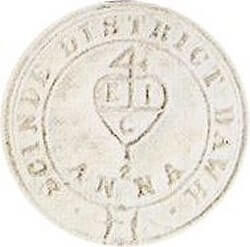
Scinde Dawk, 1852, 1/2 Anna, Blue on piece with tied Diamond of dots Cancellation, on piece is comparatively rarer than the fine used. which is worth US.$.27,000. auctioned by H.R.Harmer in June 2016
Scinde Dawk was a very old system of runners that served the Indus Valley of Sindh, (Now in Pakistan), The term also refers to the first adhesive postage stamps in Asia. The name derives from the words “Scinde”, the British spelling of the name of the province of “Sindh”, and “Dawk”, the anglicized spelling of the Hindustani word “Dak” or Post. The Dawk, or Dak, was a very old postal system of runners.
Bartle Frere of the East India Company became the Chief Commissioner of Sindh in 1850. Following the English example set by Rowland Hill, Frere improved upon the postal system of Sindh by introducing a cheap and uniform rate for postage, independent of distance travelled. In 1851 the runners were replaced with an efficient system using horses and camels, following routes through Scinde province, generally along the valley of the Indus river. The mail was carried quickly and efficiently, connecting government offices and post offices from Karachi through Kotri and Hyderabad up to Sukkur in the north.
How to identify
1. The letters E, I and C inside the central cordate insignia are sanserif in the original whereas in the forgery, all 3 letters are in serif.
2. The A of ANNA lies above S of SCINDE in the original stamp whereas in the forgery, A is shifted towards lower right.
3. The perpendicular arm of the sign 4 lies in between below S and T of DISTRICT in the genuine whereas in the forgery, it is aligned with the stem of the first T of DISTRICT.
4. All alphanumerals are much thicker in the original stamp.
Secondly, the circle of bars in black obliterator is also not what was used to cancel Scinde Dawk.
Only 2 types of cancellations are found on used Scinde Dawk.
1. Diamond of 64 (8*8) dots with diagonal dimension 19mm*17mm
2. Kardar type cancellation in which the cancelling device was touched in ink and placed on the stamp and the device was given a slight turn to imprint a strong defacement mark on the stamp.
The Scinde Dawks were first issued embossed on brittle vermilion wafers which was formerly used to seal letters as is the practice even today i.e., the use of shellac seals, chiefly for insured articles, being obligatory.
Cut square copies of the red Scinde dawks do not exist nor the large blocks, strips or pairs, known which gives a clear indication that each stamp must have been punched out from a sealing wafer.
The red Scinde Dawks were found too brittle for postage use so a new supply, embossed without color on white to bluish wove paper, varying slightly in thickness was introduced. It is not known how many stamps in a sheet were printed but there do exist an irregular block of 14. In this block none of the stamps are in alignment or equidistant both vertically as well as horizontally, hence it must be concluded that the stamps must have been embossed one at a time. Secondly, faint traces of blue lines are often found in white examples to give uniformity in margins between two stamps, thereby, also proving that they must have been embossed singly. In the royal collection there is an example of a white Scinde Dawk showing a complete square of blue dividing lines.
Once again, the new stamps with no color were found unsuitable for postal use as in the dark under candlelight they could not be distinguished especially when they were affixed on white envelopes. So a fresh order was sent to england to emboss them in blue and also to add a ring to the design, engraved on the master die.
Soon after the arrival of the Blue Scinde Dawk they were ordered to be withdrawn and destroyed as by then new stamps were issued from Calcutta for use all over India. Hence, the relative scarcity of the blue specimen. The blue Scinde Dawks come in several shades as shown in Figure 5. and they are also found with the blue dividing lines.
 |
 |
 |
 |
 |
 |
 |
Leave a Reply